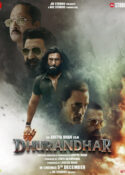 Abhi na jao chhod kar ke dil abhi bhara nahin…The film’s anthemic love ballad, regarded as one of the finest love songs ever composed for Hindi cinema, rings through your heart after the lengthy film is done – and let’s face it, nearly 3 hours of playing-time for a long-forgotten war saga can get tedious when you have the next chapter in the Egyptian civil-war waiting at home.
Abhi na jao chhod kar ke dil abhi bhara nahin…The film’s anthemic love ballad, regarded as one of the finest love songs ever composed for Hindi cinema, rings through your heart after the lengthy film is done – and let’s face it, nearly 3 hours of playing-time for a long-forgotten war saga can get tedious when you have the next chapter in the Egyptian civil-war waiting at home.
Yes, Hum Dono is back. The 1961 film about two look-alike soldiers who become friends at war, is as far-fetched in plot as…say, today’s Dabangg or James Cameron’s Avatar. Indeed the film’s old-world values of valor, integrity, loyalty, fidelity and trustworthiness seem to belong to another era, if not a completely different planet. They are rescued from fading by compter-coloured velocity.
Admittedly even today Hum Dono makes a fairly engaging triangular love story with war at its backdrop. The coloured version that has come to us now leaves us with mixed feelings. Though at first one enjoys the splash of colour that is added to V Ratra’s outstanding black-and-white cinematography a lot of the film’s original visual intensity is lost in colorized translation.
We are left wondering who decided what colour Dev Anand‘s shirt or Sadhana‘s saree was meant to be!Did the color-generating department check with the film’s core team to decide the colour schemes? If not, is it ethical or even legally permissible to tamper with the film’s creators’ original vision?
The Dolby-enhanced sound leaves no room for quibble. Jaidev’s music score, considered by many aficionados to be one the 10 finest Hindi motion-picture soundtracks of all times, heals all the wounds of excessive coloured flamboyance. Whether it is Mohd Rafi and Asha Bhosle’s ‘Abhi na jao chhod kar’ or Lata Mangeshlar’s immortal Bhajan ‘Allah tero naam’, or those two imperishable Rafi Ghazals ‘Kabhi khud pe kabhi halaat pe rona aaya’ and ‘Main zindagi ka saath nibhata chala gaya’…you just can’t help being swept into the sheer melody of the moment.
The casually stylish way the songs are shot, the sharp close-ups being intercut with lyrical poetic long-shots, incidental but intense interludes of passion played out in the visual detailing, all carry the distinctive stamp of Vijay Anand who wrote Hum Dono. The film’s direction is credited to Amarjeet who later directed Dev Anand in a film called Gambler.
Ah, Dev Anand…a star beyond any definition of stardom!! He shines with meteoric melancholy in the double role of men at war with themselves, much more than for his country. The way this debonair actor enacts the solo numbers by Rafi makes you wonder if the the song came first? Or was the song inspired by the face that conveys the numbers on screen?
Sadhana (impish,coquettish) and Nanda (tremulously poignant) are lovely supplements to the Dev Anand mystique. What was he thinking when he romanced these beautiful ladies? Surely more than what Sahir Ludhianvi’s love-lorn lyrics describe!
They don’t make stars like Dev Anand any more. They never will. Or for that matter a film so suffused in the splendour of its own cultivated grace is impossibly to come by in today’s era of pelvic passion.
Abhi na jaao chhod kar indeed.
Rating: ***









